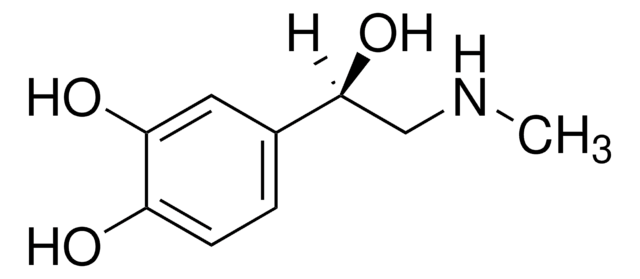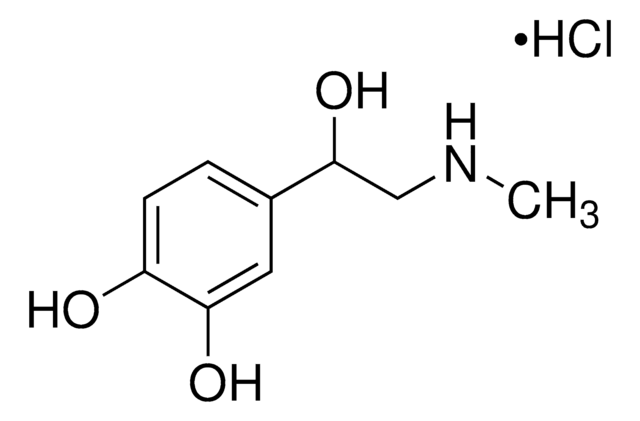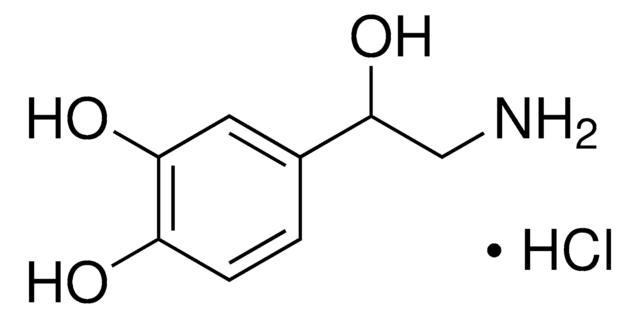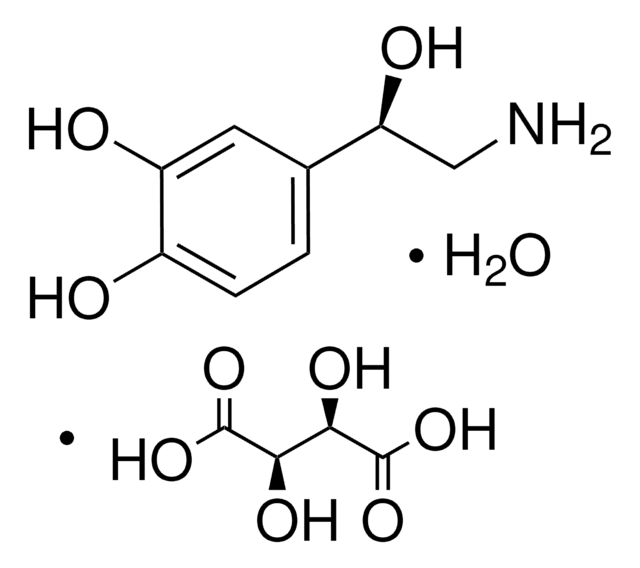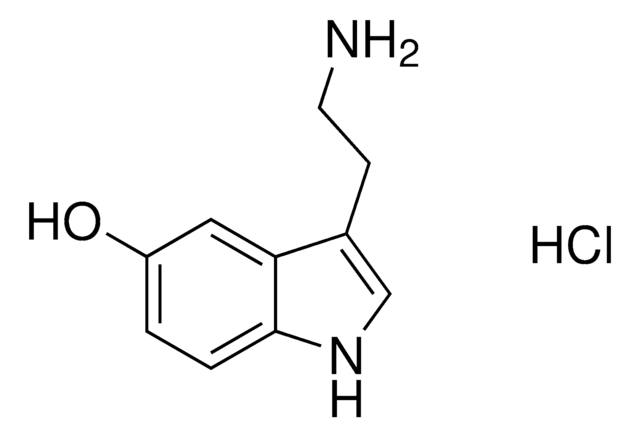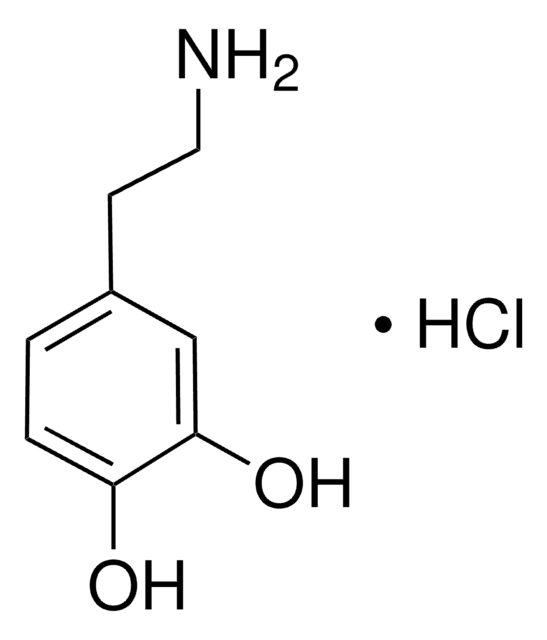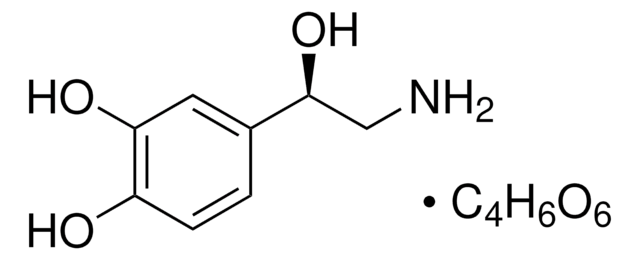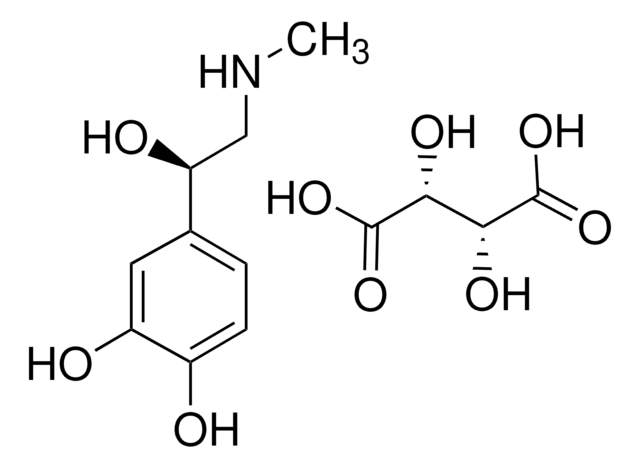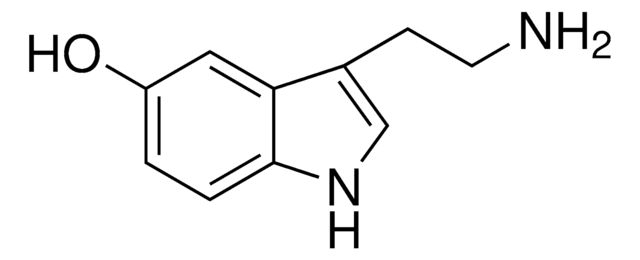A7257
(−)-Norepinephrine
≥98% (TLC), crystalline, adrenergic neurotransmitter
Synonym(s):
(R)-4-(2-Amino-1-hydroxyethyl)-1,2-benzenediol, L-Arterenol, L-Noradrenaline, Levarterenol
About This Item
Recommended Products
Product Name
(−)-Norepinephrine, ≥98%, crystalline
Quality Level
Assay
≥98%
form
crystalline
color
off-white to tan
storage temp.
−20°C
SMILES string
NC[C@H](O)c1ccc(O)c(O)c1
InChI
1S/C8H11NO3/c9-4-8(12)5-1-2-6(10)7(11)3-5/h1-3,8,10-12H,4,9H2/t8-/m0/s1
InChI key
SFLSHLFXELFNJZ-QMMMGPOBSA-N
Gene Information
human ... ADRA1A(148) , ADRA1B(147) , ADRA1D(146) , ADRA2A(150) , ADRA2B(151) , ADRA2C(152) , ADRB1(153) , ADRB2(154) , ADRB3(155)
rat ... Adra1a(29412) , Adra1d(29413) , Adra2a(25083) , Adrb1(24925) , Adrb2(24176) , Drd1a(24316) , Drd2(24318)
Looking for similar products? Visit Product Comparison Guide
General description
Application
- as anαand β-AR agonist to stimulate mouse organoids to study the pathways that are activated upon intestinal epithelial adrenergic receptor (AR) stimulation,
- to measure the monoamine levels in various limbic regions of mouse brains by high-performance liquid chromatography (HPLC) coupled with an electrochemical equipped with an auto-sampler,
- as a dispersal agent in biofilm dispersion assay to study its effects on the dispersal of Mannheimia haemolytica biofilms
Features and Benefits
Signal Word
Danger
Hazard Statements
Precautionary Statements
Hazard Classifications
Acute Tox. 1 Inhalation - Acute Tox. 2 Dermal - Acute Tox. 2 Oral
Storage Class Code
6.1B - Non-combustible acute toxic Cat. 1 and 2 / very toxic hazardous materials
WGK
WGK 3
Personal Protective Equipment
Regulatory Information
Choose from one of the most recent versions:
Certificates of Analysis (COA)
Don't see the Right Version?
If you require a particular version, you can look up a specific certificate by the Lot or Batch number.
Already Own This Product?
Find documentation for the products that you have recently purchased in the Document Library.
Which document(s) contains shelf-life or expiration date information for a given product?
If available for a given product, the recommended re-test date or the expiration date can be found on the Certificate of Analysis.
How do I get lot-specific information or a Certificate of Analysis?
The lot specific COA document can be found by entering the lot number above under the "Documents" section.
How should Product A7257, (-)-Norepinephrine, be dissolved?
This product is soluble in 0.5M HCl at a concentration of 50mg/mL, yielding a clear faint yellow solution.
What are the differences between Product No. A7257, (-)-Norepinephrine and Product No. A0937, (±)-Norepinephrine (+)-bitartrate salt?
Product No. A7257, is the free base form of the (-) isomer; it is not water soluble. Product No. A0937 is the bitartrate salt of the racemic (+/-) mixture; it is soluble in water at a concentration of 50 mg/mL.
How long is a solution of Product A7257, (-)-Norepinephrine, stable?
A stock solution of 1 mg/ml or greater may be stored frozen in aliquots. Avoid freeze-thaw cycles. When the solution gets a pink cast, the product has degraded.
How do I find price and availability?
There are several ways to find pricing and availability for our products. Once you log onto our website, you will find the price and availability displayed on the product detail page. You can contact any of our Customer Sales and Service offices to receive a quote. USA customers: 1-800-325-3010 or view local office numbers.
What is the Department of Transportation shipping information for this product?
Transportation information can be found in Section 14 of the product's (M)SDS.To access the shipping information for this material, use the link on the product detail page for the product.
My question is not addressed here, how can I contact Technical Service for assistance?
Ask a Scientist here.
Articles
DISCOVER Bioactive Small Molecules for Neuroscience
Our team of scientists has experience in all areas of research including Life Science, Material Science, Chemical Synthesis, Chromatography, Analytical and many others.
Contact Technical Service